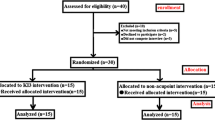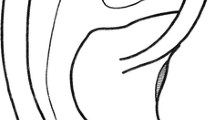Abstract
Although acupuncture is effective for treating pain, its site-specificity is questioned. The aim was to compare the cerebral responses of needling applied to an acupuncture point to the needling of a sham point, using functional magnetic resonance imaging (fMRI). Twenty-one healthy male volunteers were enrolled. Manual stimulation of the acupuncture (ST44) and sham points on the dorsum of the left foot was applied during fMRI in a crossover manner. fMRI data analysis was performed contrasting the ST44 and the sham conditions. Stimulation intensity, subjective discrimination of the needling site and the incidence of “Qi” sensation were additionally recorded. Stimulation of ST44 acupoint, in comparison to the sham procedure, was associated with an increased fMRI-activation in the primary somatosensory, the inferior parietal and the prefrontal cortex and the posterior insula. Sham needling was associated with increased activation in the anterior cingulate cortex and the anterior insula. Verum acupuncture increased the activity of discriminative somatosensory and cognitive pain processing areas of the brain, whereas sham needling activated the areas responsible for affective processing of pain. This may explain favorable effects of verum acupuncture in clinical studies about treatment of chronic pain patients.



Similar content being viewed by others
References
Alecrim-Andrade, J., Maciel-Júnior, J. A., Carnè, X., Severino Vasconcelos, G. M., & Correa-Filho, H. R. (2008). Acupuncture in migraine prevention: a randomized sham controlled study with 6-months posttreatment follow-up. Clinical Journal of Pain, 24(2), 98–105.
Apkarian, A. V., Bushnell, M. C., Treede, R. D., & Zubieta, J. K. (2005). Human brain mechanisms of pain perception and regulation in health and disease. European Journal of Pain, 9(4), 463–484.
Bär, K. J., Berger, S., Schwier, C., Wutzler, U., & Beissner, F. (2013). Insular dysfunction and descending pain inhibition in anorexia nervosa. Acta Psychiatrica Scandinavica, 127(4), 269–278.
Björnsdotter, M., Löken, L., Olausson, H., Vallbo, A., & Wessberg, J. (2009). Somatotopic organization of gentle touch processing in the posterior insular cortex. Journal of Neuroscience, 29(29), 9314–9320.
Chae, Y., Chang, D. S., Lee, S. H., Jung, W. M., Lee, I. S., Park, H. J., et al. (2013). Inserting needles into the body: a meta-analysis of brain activity associated with acupuncture needle stimulation. The Journal of Pain, 14(3), 215–222.
Diener, H. C., Kronfeld, K., Boewing, G., Lungenhausen, M., Maier, C., Molsberger, A., et al. (2006). Efficacy of acupuncture for the prophylaxis of migraine: a multicentre randomised controlled clinical trial. Lancet Neurology, 5(4), 310–316.
Facco, E., Liguori, A., Petti, F., Zanette, G., Coluzzi, F., De Nardin, M., et al. (2008). Traditional acupuncture in migraine: a controlled, randomized study. Headache, 48(3), 398–407.
Fang, J., Jin, Z., Wang, Y., Li, K., Kong, J., Nixon, E. E., et al. (2009). The salient characteristics of the central effects of acupuncture needling: limbic-paralimbic-neocortical network modulation. Human Brain Mapping, 30(4), 1196–1206.
Friebel, U., Eickhoff, S. B., & Lotze, M. (2011). Coordinate-based meta-analysis of experimentally induced and chronic persistent neuropathic pain. NeuroImage, 58(4), 1070–1080.
Friston, K. J., Holmes, A. P., Worsley, K. J., Poline, J. B., Frith, C., & Frackowiak, R. S. J. (1994). Statistical parametric maps in functional imaging: a general linear approach. Human Brain Mapping, 2(4), 189–210.
Haake, M., Müller, H. H., Schade-Brittinger, C., Basler, H. D., Schäfer, H., Maier, C., et al. (2007). German Acupuncture Trials (GERAC) for chronic low back pain: randomized, multicenter, blinded, parallel-group trial with 3 groups. Archives of Internal Medicine, 167(17), 1892–1898.
Han, J. S. (2004). Acupuncture and endorphins. Neuroscience Letters, 361(1–3), 258–261.
Harris, R. E., Zubieta, J. K., Scott, D. J., Napadow, V., Gracely, R. H., & Clauw, D. J. (2009). Traditional Chinese acupuncture and placebo (sham) acupuncture are differentiated by their effects on mu-opioid receptors (MORs). NeuroImage, 47(3), 1077–1085.
Ho, T. J., Duann, J. R., Chen, C. M., Chen, J. H., Shen, W. C., Lu, T. W., et al. (2008). Carryover effects alter FMRI statistical analysis in an acupuncture study. American Journal of Chinese Medicine, 36(1), 55–70.
Huang, W., Pach, D., Napadow, V., Park, K., Long, X., Neumann, J., et al. (2012). Characterizing acupuncture stimuli using brain imaging with FMRI–a systematic review and meta-analysis of the literature. PLoS One, 7(4), e32960.
Hui, K. K., Liu, J., Makris, N., Gollub, R. L., Chen, A. J., Moore, C. I., et al. (2000). Acupuncture modulates the limbic system and subcortical gray structures of the human brain: evidence from fMRI studies in normal subjects. Human Brain Mapping, 9(1), 13–25.
Hui, K. K., Marina, O., Claunch, J. D., Nixon, E. E., Fang, J., Liu, J., et al. (2009). Acupuncture mobilizes the brain’s default mode and its anti-correlated network in healthy subjects. Brain Research, 1287, 84–103.
Hui, K. K., Marina, O., Liu, J., Rosen, B. R., & Kwong, K. K. (2010). Acupuncture, the limbic system, and the anticorrelated networks of the brain. Autonomic Neuroscience, 157(1–2), 81–90.
Li, Y., Zheng, H., Witt, C. M., Roll, S., Yu, S. G., Yan, J., et al. (2012). Acupuncture for migraine prophylaxis: a randomized controlled trial. CMAJ, 184(4), 401–410.
Lin, C. S., Hsieh, J. C., Yeh, T. C., Lee, S. Y., & Niddam, D. M. (2013). Functional dissociation within insular cortex: the effect of pre-stimulus anxiety on pain. Brain Research, 1493, 40–47.
Linde, K., Streng, A., Jürgens, S., Hoppe, A., Brinkhaus, B., Witt, C., et al. (2005). Acupuncture for patients with migraine: a randomized controlled trial. JAMA, 293(17), 2118–2125.
Linde, K., Allais, G., Brinkhaus, B., Manheimer, E., Vickers, A., & White, A. R. (2009). Acupuncture for tension-type headache. Cochrane Database of Systematic Reviews, 1, CD007587.
Lorenz, J., Minoshima, S., & Casey, K. L. (2003). Keeping pain out of mind: the role of the dorsolateral prefrontal cortex in pain modulation. Brain, 126(Pt5), 1079–1091.
Lundeberg, T., Lund, I., Näslund, J., & Thomas, M. (2008). The Emperors sham - wrong assumption that sham needling is sham. Acupuncture in Medicine, 26(4), 239–242.
Maeda, Y., Kettner, N., Lee, J., Kim, J., Cina, S., Malatesta, C., et al. (2013). Acupuncture-evoked response in somatosensory and prefrontal cortices predicts immediate pain reduction in carpal tunnel syndrome. Evidence-based Complementary and Alternative Medicine, 2013, 795906. doi:10.1155/2013/795906.
Melchart, D., Streng, A., Hoppe, A., Brinkhaus, B., Witt, C., Wagenpfeil, S., et al. (2005). Acupuncture in patients with tension-type headache: randomised controlled trial. BMJ, 331(7513), 376–382.
Moffet, H. H. (2009). Sham acupuncture may be as efficacious as true acupuncture: a systematic review of clinical trials. Journal of Alternative and Complementary Medicine, 15(3), 213–216.
Molsberger, A. F., Boewing, G., Diener, H. C., Endres, H. G., Kraehmer, N., Kronfeld, K., et al. (2006). Designing an acupuncture study: the nationwide, randomized, controlled, German acupuncture trials on migraine and tension-type headache. Journal of Alternative and Complementary Medicine, 12(3), 237–245.
Napadow, V., Kettner, N., Liu, J., Li, M., & Kwong, K. K. (2007). Hypothalamus and amygdala response to acupuncture stimuli in Carpal Tunnel Syndrome. Pain, 130(3), 254–266.
Ossipov, M. H., Dussor, G. O., & Porreca, F. (2010). Central modulation of pain. Journal of Clinical Investigation, 120(11), 3779–3787.
Petrovic, P., Kalso, E., Petersson, K. M., & Ingvar, M. (2002a). Placebo and opioid analgesia-imaging a shared neuronal network. Science, 295(5560), 1737–1740.
Petrovic, P., Petersson, K. M., Hansson, P., & Ingvar, M. (2002b). A regression analysis study of the primary somatosensory cortex during pain. NeuroImage, 16(4), 1142–1150.
Quah-Smith, I., Sachdev, P. S., Wen, W., Chen, X., & Williams, M. A. (2010). The brain effects of laser acupuncture in healthy individuals: an FMRI investigation. PLoS One, 5(9), e12619.
Shmuelof, L., & Zohary, E. (2005). Dissociation between ventral and dorsal fMRI activation during object and action recognition. Neuron, 47(3), 457–470.
Siedentopf, C. M., Koppelstaetter, F., Haala, I. A., Haid, V., Rhomberg, P., Ischebeck, A., et al. (2005). Laser acupuncture induced specific cerebral cortical and subcortical activations in humans. Lasers in Medical Science, 20(2), 68–73.
Sun, Y., & Gan, T. J. (2008). Acupuncture for the management of chronic headache: a systematic review. Anesthesia and Analgesia, 107(6), 2038–2047.
Tracey, I., & Mantyh, P. W. (2007). The cerebral signature for pain perception and its modulation. Neuron, 55(3), 377–391.
Vogt, B. A. (2005). Pain and emotion interactions in subregions of the cingulate gyrus. Nature Review Neuroscience, 6(7), 533–544.
White, A., Foster, N. E., Cummings, M., & Barlas, P. (2007). Acupuncture treatment for chronic knee pain: a systematic review. Rheumatology (Oxford), 46(3), 384–390.
Zhao, Z. Q. (2008). Neural mechanism underlying acupuncture analgesia. Progress in Neurobiology, 85(4), 355–375.
Acknowledgments
The authors thank the volunteers, who took part in this investigation.
Disclosures
This study was funded from the institutional sources. Taras I. Usichenko, Toni Wesolowski & Martin Lotze declare no conflicts of interest.
All procedures followed were in accordance with the ethical standards of the responsible committee on human experimentation (institutional and national) and with the Helsinki Declaration of 1975, as revised in 2000. Informed consent was obtained from all patients for being included in the study.
Author information
Authors and Affiliations
Corresponding author
Additional information
Dr. Usichenko and Mr. Wesolowski made equal contributions in conducting the investigation and writing the manuscript.
Rights and permissions
About this article
Cite this article
Usichenko, T.I., Wesolowski, T. & Lotze, M. Verum and sham acupuncture exert distinct cerebral activation in pain processing areas: a crossover fMRI investigation in healthy volunteers. Brain Imaging and Behavior 9, 236–244 (2015). https://doi.org/10.1007/s11682-014-9301-4
Published:
Issue Date:
DOI: https://doi.org/10.1007/s11682-014-9301-4




